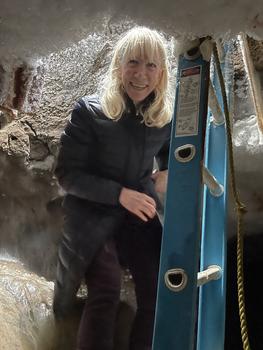This summer, computer modeling and the Arctic ecosystem converged at the top of the world. Professor Elise Miller-Hooks and a team of National Science Foundation (NSF) researchers convened at the Barrow Arctic Research Center. These NSF Navigating the New Arctic researchers traveled to the remote location to attend the Permafrost and Infrastructure Symposium in Utqiaġvik, Alaska, some 320 miles north of the Arctic Circle.
The symposium brought together scientists, regional planners, village leaders, project managers, and federal and local policy makers. The team attended to learn and grow their research–and to share. Miller-Hooks described what she learned as massive.
“It was nothing like I expected. When I entered Utqiaġvik, I found myself in a tough environment with mostly dirt roads. The other researchers told me these roadways are built on permafrost,” she said. “Later on, they convinced me to lower myself into a cave underground to see 16,000-year-old permafrost.”

The people of Utqiaġvik live on the permafrost and they still fish and whale in the surrounding seas, as they have for centuries. Whaling is not a hobby, or for profit. They whale to survive. It is their food supply and more.
“It [whaling] is their culture. It is what they raise their kids to do. It's what their songs and dances are about. It's truly everything. They say that if you take that away from them, it's like killing them,” said Miller-Hooks. All of this could be threatened by more shipping traffic as the polar ice caps shrink and Arctic sea ice diminishes.
Most of the researchers at the symposium were there to study the permafrost which is thawing because of human-made climate change; when the permafrost thaws, the land under the structures that have been built on it sinks. Miller-Hooks described the situation as the base falling out from under them and said that they need to find solutions now, not tomorrow. With very limited access to materials, finding a solution is especially challenging.
Miller-Hooks’ research focuses on forecasting and modeling shipping and maritime transportation changes that will come as the permafrost thaws and the sea-level rises. She said she doesn’t get out in the field much in her line of work but found the experience life changing.
This idea crystalized after Miller-Hooks presented her research at the symposium. After her presentation, one of the village leaders expressed concern and skepticism about the math.
He said he thought she was looking at the wrong thing. He told her that more shipping in the Arctic would harm the whales and could harm whaling.
Miller-Hooks explained that her research creates the tools that can help forecast changing Arctic traffic, and how these projections and analyses can be used to help make cases to mitigate the impact on the whales and their breeding, other marine life, whale hunting, and indigenous people’s subsistence way of life.
“Now I have a much better understanding of the power of the results that we will get, and how they can be used from many new angles that I hadn't thought of,” she said. Miller-Hooks hopes to collaborate with the communities and work with them to uncover how increased maritime traffic and related industrial activity in the region will impact their way of life, and how the U.S. and other Arctic nations can prepare to do the right thing.
Research Sponsors: Funding for the symposium came from the NSF Arctic Sciences program, the U.S. Department of Transportation's Center for Safety Equity in Transportation, and UIC Science, a subsidiary of the Ukpeaġvik Iñupiat Corporation providing logistical support to scientists and researchers working in Alaska's Arctic.
